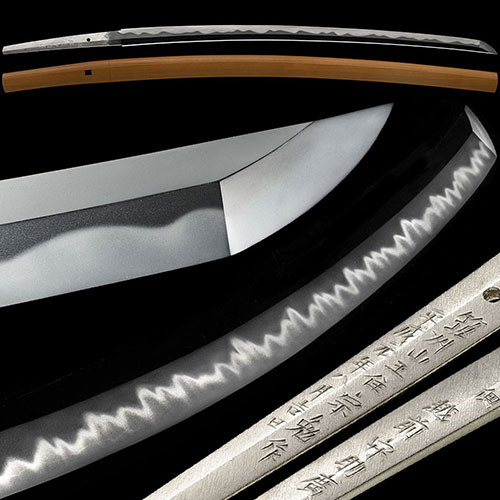
宗勉 刀Sou Tsutomu Katana
No.267394偲 越前守助広 筑州山王住宗勉作 平成元年 無監査 濤瀾乱 沸匂深く地刃明るく冴える最高傑作 身幅3.5cm 二尺五寸Shinobu Echizennokami Sukehiro Chikusyuu Sannou jyu Sou Tsutomu-saku 1989 Mukansa Toran-midare Deep Nie -Nioi, Jiba is bright and clear Mihaba Width 3.5cm The best masterpiece 75.6cm
ご成約Sold
- 銘表Mei-Omote
- 偲 越前守助広 偲 越前守助広 Shinobu Echizennokami Sukehiro
- 裏銘Ura-mei
- 筑州山王住宗勉作 平成元年八月吉日筑州山王住宗勉作 平成元年八月吉日 Chikusyuu Sannou jyu Sou Tsutomu 1989
- 登録証Registration
- 福岡県 Fukuoka 昭和10年6月18日 6/18/10(Showa)
- 法量Size
-
刃長 75.6cm (二尺五寸) 反り 1.8cm
元幅 3.5cm 先幅 2.4cm 元重 0.69cm 鎬厚 0.76cm 先重 0.50cm 鋒長 3.8cm 茎長 24.0cm 重量 923gHachou 75.6cm (二尺五寸) Sori 1.8cm
Moto-Haba 3.5cm Saki-Haba 2.4cm Moto-Kasane 0.69cm Shinogi-Thikess 0.76cm Saki-Kasane 0.50cm Kissaki-Chou 3.8cm Nakago-Chou 24.0cm Weight 923g - 姿Shape
- 鎬造、庵棟、身幅広く、先幅も広く、反りやや深く、中鋒。Shinogidukuri, Iorimune, Wide Mihaba, Wide Sakihaba too, Sori is a little deep, Chu-Kissaki
- 鍛Kitae
- 小板目肌つみ、小杢目肌交じり、地沸微塵に厚くつき、地景細かく頻りに入り、鉄明るく冴える。Small Itamehada-tsumi, Mixed small-mokumehada, Jinie entered fine and thick, Chikei entered fine and frequent, Iron is bright and clear.
- 刃文Hamon
- 大互の目に、互の目交じり、沸深くよくつき、砂流し掛り、匂深く、匂口明るく冴える。Oh-gunome, Mixed Gunome, Deep Nie often entered, Sunagashi-kakari, Deep Nioi, Nioikuchi is bright and clear.
- 帽子Boushi
- 直ぐに小丸、深く返る。Suguni-komaru, Deep-kaeru
- 茎Nakago
- 生ぶ、先栗尻、鑢目筋違化粧、目釘孔一。Ubu, Sakikurijiri, Yasurimesujikai-kesyou, Mekugiana is 1
- ハバキHabaki
- 金着二重。Double gold.
- 説明Drscription
- 宗勉刀匠は、名を宗勝といい、昭和2年に福岡に生まれ、昭和21年より父の宗正光に師事、昭和30年より新作名刀展に出品、文化庁長官賞、薫山賞など数多くの特賞を受賞し、平成2年には無鑑査に認定される。作風は、父の目指した左文字、虎徹を範として沸の強く、金筋・砂流しのよく働いた相州伝を踏襲、その後清麿に挑戦し、「清麿の宗」と異名をとるほどになり、さらに晩年には越前守助広の濤欄刃にも挑戦し成功している。その技術は秀逸で、宗勉刀匠の清麿写しが銘を切り直し、重要の清麿になっているという話もある。平成27年2月没。この刀は、二尺五寸の長さに、身幅広く3.5cmもあり、先幅も広く、重量も923gもある精悍な豪壮刀で、小板目肌つみ、小杢目肌交じり、地沸微塵に厚くつき、地景細かく入り、明るく冴えた精良で美しい地鉄に、砂流し掛り、沸匂深い濤瀾刃を焼き、匂口明るく冴え渡る最高傑作である。一点の緩みも欠点も無く、銘にも表に偲 越前守助広と入るように、助広の濤瀾を写して成功した自信のほどが窺われる見事な作品で、助広の銘を切れば助広で重要になるような出来栄えである。Sou Tsutomu swordsman, whose name is Munekatsu, was born in Fukuoka in 1945. Received the special prize of, He studied under his father Sou Masamitsu in 1946, exhibited in a new masterpiece sword exhibition in 1955, received numerous special awards such as the Agency for Cultural Affairs Commissioner's Award and the Kunzan Award, and was certified as Mukansa in 1990. His style was based on his father's Samonji, Kotetsu's strong Nie, and Kinsuji and Sunagashi's well-worked Sosyu-den. He later challenged Kiyomaro, and was nicknamed "Kiyomaro no Mune". In his later years, he even challenged Echizen no Kami Sukehiro's Toran-ha and succeeded.His technique was so excellent that some swordsmiths made copies of Kiyomaro by Tsutomu Mune, and the signature was changed to Kiri-naoshi, or Kiyomaro of Juyo. He passed away in February 2015.
This sword is 75.6 cm long, 3.5 cm wide, has a wide Sakihaba, and weighs 923 g.With a fearless and magnificent sword, Mixed Small-Mokumehada, Jinie entered fine and thick, Chikei entered fine and frequent, Jitetsu is beautiful , clear and bright, Sunagashi-kakari, Deep Nie and Nioi, Toran-yaki, Nioikuchi is bright and clear, masterpiece.
There is no looseness or flaws in one point, and it is a wonderful work that shows the confidence that Sukehiro's Toran was successful by copying Sukehiro's Toran so that Mei also has Shinobu Echizennokami Sukehiro on the table.If This sword turn off Sukehiro's Mei, It'll be able to become Juyo with Sukehiro.


